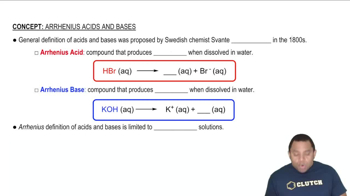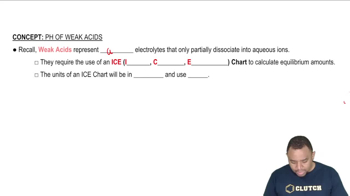Here are the essential concepts you must grasp in order to answer the question correctly.
Acid-Base Chemistry
Acid-base chemistry involves the study of acids, bases, and their reactions. Acids are substances that donate protons (H+ ions), while bases accept protons. The strength of an acid is often measured by its acid dissociation constant (Ka), which indicates how well it ionizes in solution. Understanding these principles is essential for calculating pH and determining the behavior of substances in aqueous solutions.
Recommended video:
Arrhenius Acids and Bases
pH Scale
The pH scale quantifies the acidity or basicity of a solution, ranging from 0 to 14. A pH of 7 is neutral, below 7 is acidic, and above 7 is basic. The pH is calculated using the formula pH = -log[H+], where [H+] is the concentration of hydrogen ions in the solution. Knowing how to calculate pH is crucial for understanding the effects of acids and bases in chemical reactions.
Recommended video:
Dissociation of Weak Acids
Weak acids, like ascorbic acid, do not fully dissociate in solution, meaning only a fraction of the acid molecules release protons. The degree of dissociation can be described using the acid dissociation constant (Ka). For ascorbic acid, the given Ka value indicates its weak acidic nature, which is important for calculating the concentration of hydrogen ions and, consequently, the pH of the solution after dissolving the vitamin C tablet.
Recommended video:
 Verified step by step guidance
Verified step by step guidance


